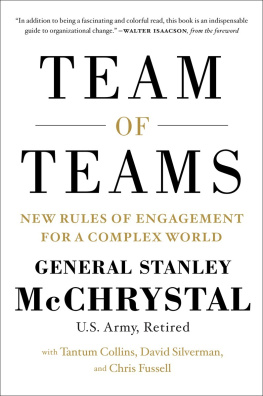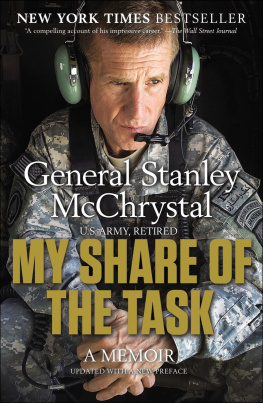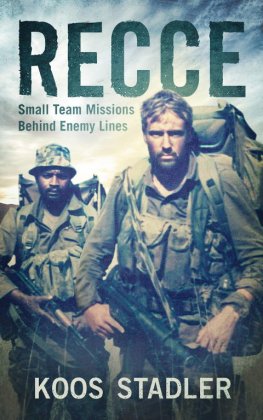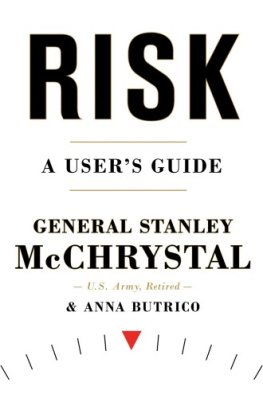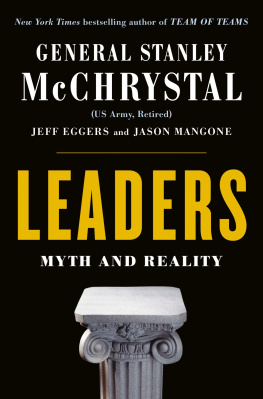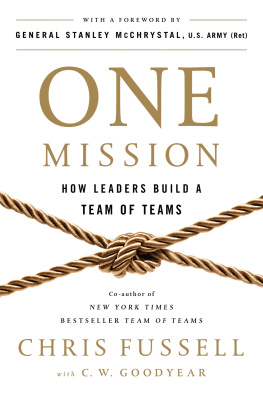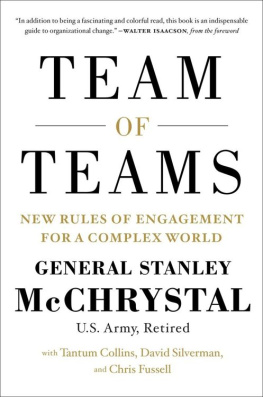ALSO BY GENERAL STANLEY McCHRYSTAL (U.S. Army, Retired)
USA | Canada | UK | Ireland | Australia | New Zealand | India | South Africa | China
First published by Portfolio / Penguin, an imprint of Penguin Publishing Group, a division of Penguin Random House LLC, 2015
Penguin supports copyright. Copyright fuels creativity, encourages diverse voices, promotes free speech, and creates a vibrant culture. Thank you for buying an authorized edition of this book and for complying with copyright laws by not reproducing, scanning, or distributing any part of it in any form without permission. You are supporting writers and allowing Penguin to continue to publish books for every reader.
FOREWORD BY WALTER ISAACSON
Whether in business or in war, the ability to react quickly and adapt is critical, and its becoming even more so as technology and disruptive forces increase the pace of change. That requires new ways to communicate and work together. In todays world, creativity is a collaborative endeavor. Innovation is a team effort.
This book draws timely lessons for any organization seeking to triumph in this new environment. Based on very real and vividly described situations that General McChrystal encountered as a commander in Iraq and Afghanistan, it describes how organizations need to reinvent themselves. This involves breaking down silos, working across divisions, and mastering the flexible response that comes from true teamwork and collaboration.
I have observed this phenomenon in my own study of innovation in the digital age. The greatest innovations have not come from a lone inventor or from solving problems in a top-down, command-and-control style. Instead, the great successesthe creation of the computer, transistor, microchip, Internetcome from a team of teams working together in pursuit of a common goal.
I once asked Steve Jobs, often mistakenly considered a lone visionary and authoritarian leader, which of his creations made him most proud. I thought he might say the original Macintosh, or the iPhone. Instead he pointed out that these were all collaborative efforts. The creations he was most proud of, he said, were the teams he had produced, starting with the original Macintosh team working under a pirate flag in the early 1980s and the remarkable team he had assembled by the time he stepped down from Apple in 2011.
Todays rapidly changing world, marked by increased speed and dense interdependencies, means that organizations everywhere are now facing dizzying challenges, from global terrorism to health epidemics to supply chain disruption to game-changing technologies. These issues can be solved only by creating sustained organizational adaptability through the establishment of a team of teams.
High-speed networks and digital communications mean that collaboration canand musthappen in real time. The distributed, decentralized, and weblike architecture of the Internet empowers each individual to be a collaborator. Likewise the necessity of real-time innovation and problem-solving requires integrative and transparent leadership that empowers individual team members.
This new environment gave Al Qaeda a distinct advantage, allowing the networked organization to strike rapidly, reconfigure in real time, and integrate its globally dispersed actions. At first, this overwhelmed the Task Force led by General McChrystal, a traditional, secretive, siloed military hierarchy that was configured to solve the problems of an earlier era.
The solution was, surprisingly, found in changing management structures. The U.S. military and its allies had to transform the way the special operations community operated, changing the way it waged the War on Terror.
The experience of General McChrystal and his colleagues, and their examination of the experiences of others, taught them that complexity at scale has rendered reductionist management ineffective for solving these issues in our networked world. Efficiency is necessary but no longer sufficient to be a successful organization. It worked in the twentieth century, but it is now quickly overwhelmed by the speed and exaggerated impact of small players, such as terrorists, start-ups, and viral trends.
Management models based on planning and predicting instead of resilient adaptation to changing circumstances are no longer suited to todays challenges. Organizations must be networked, not siloed, in order to succeed. Their goal must shift from efficiency to sustained organizational adaptability. This requires dramatic shifts in mental and organizational models, as well as sustained efforts on the part of leadership to create the environment for such a change.
General McChrystals experiences leading the Task Force illustrate how this dramatic transformation is possible in all organizations. After identifying the adaptable and networked nature of Al Qaeda, the general and his team explored why traditional organizations arent adaptable. One conclusion they reached was that agility and adaptability are normally limited to small teams. They explored the traits that make small teams adaptable, such as trust, common purpose, shared awareness, and the empowerment of individual members to act. They also identified the traditional limits of teams, such as blinks in the organization between teams where collaboration begins to break down.
The primary lesson that emerged, and is detailed in this book, is the need to scale the adaptability and cohesiveness of small teams up to the enterprise level. This involves creating a team of teams to foster cross-silo collaboration. That way the insights and actions of many teams and individuals can be harnessed across the organization. Innovation and problem solving become the products of teamwork, not a single architect.
Doing this requires increasing transparency to ensure common understanding and awareness. It also often involves changing the physical space and personal behaviors to establish trust and foster collaboration. This can develop the ability to share context so that the teams can decentralize and empower individuals to act. Decisions are pushed downward, allowing the members to act quickly. This new approach also requires changing the traditional conception of the leader. The role of the leader becomes creating the broader environment instead of command-and-control micromanaging.
Harnessing and sharing the power and experiences of many teams allowed the Task Force command to adapt quickly to changing events on the ground and innovate solutions that couldnt have come from a top-down approach.
These lessons, as the authors show, apply to business and other organizations as well. General McChrystal is leading an effort, managed at the Aspen Institute, to make a year of national service, military or domestic, an opportunity and an expectation of all young Americans. Participating in a service corps is one of many ways to learn to work as a team, communicate goals, and empower decentralized decision making.

